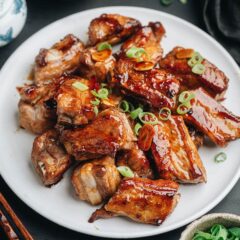
Sweet and Sour Ribs (糖醋小排)
Sweet and sour ribs is a classic Shanghainese appetizer that will be the highlight of your dinner table. The ribs are browned with sugar until crispy and caramelized, then finished up in a sticky and fragrant sweet and sour sauce.
Ingredients
For boiling ribs
- 1.5 lb (750 g) pork spare ribs , trimmed to 2” (5 cm) in length, cut into one-bone sections (*footnote 1)
- 2 tablespoons Shaoxing wine
- 1 thumb-size ginger , sliced
- 5 to 6 green onion white part , green part sliced for garnish
- 1 whole star anise
- 2 dried chili pepper
For the stir-fry
- 2 tablespoons Chinkiang vinegar
- 1 tablespoon light soy sauce (or soy sauce)
- 4 tablespoons peanut oil (or vegetable oil)
- 3 tablespoons sugar , separated
- 2 cloves garlic , sliced
Instructions
- Add the pork ribs to a large pot. Add cold tap water to cover the ribs. Add the Shaoxing wine, ginger, green onion, star anise and chili pepper to the pot. Cover and cook over medium-high heat until brought to a boil. Uncover and continue to cook for 5 minutes. Use a ladle to skim the foam from the surface and discard it. Once done, transfer the ribs to a colander to drain. You can strain and save the broth, so you can use it to make a soup later (*see footnote 2).
- Mix the black vinegar, light soy sauce and 1 tablespoon of the sugar in a small bowl, set aside.
- Add the peanut oil to a large nonstick skillet, then carefully sprinkle the remaining 2 tablespoons of the sugar so it spreads out into a thin layer in full contact with the oil. Cook over medium heat. Swirl the pan occasionally to help the sugar keep contact with the oil, to help with even dissolving. If the sugar has trouble distributing evenly, it’s OK to use a spatula to spread it. But you shouldn’t stir the sugar too much, which will cause crystallization. Observe the sugar carefully when the color starts to turn pale yellow. You might need to lower the heat if a portion of the sugar is turning color too fast and the rest of the sugar has not dissolved yet. When most of the sugar turns golden, carefully add the ribs to the wok. Stir constantly to coat the ribs well with melted sugar. Stir until the ribs turn golden brown, then turn off the heat.
- Transfer all the ribs to a plate and set aside. Pour the oil into a bowl and wipe the pan clean with paper towels.
- Add back 2 teaspoons of the oil and turn the stove back to medium-high heat. Add the garlic. Stir a few times to release the fragrance.
- Pour in the vinegar mixture. Cook and stir until the sauce has reduced by half and become thicker. Add the ribs back and continue stirring to coat the ribs evenly. Transfer everything to a plate and garnish the ribs with chopped green onion. Serve hot or at room temperature as an appetizer or main dish.
Notes
- You will find this type of ribs at most Asian markets. If you shop at a regular grocery store, ask the butcher to chop the ribs into smaller pieces when buying. Try to select a thin and small rack of ribs, because a thick cut won’t absorb the flavor well and the meat will be too tough in a stir-fry.
- The broth will be quite flavorful and you can use it as a soup base, for example, to cook a winter melon meatball soup.
Nutrition
Serving: 1serving, Calories: 271kcal, Carbohydrates: 9.8g, Protein: 20.1g, Fat: 16.2g, Saturated Fat: 3.2g, Cholesterol: 55mg, Sodium: 269mg, Potassium: 333mg, Fiber: 0.1g, Sugar: 9.1g, Calcium: 8mg, Iron: 1mg